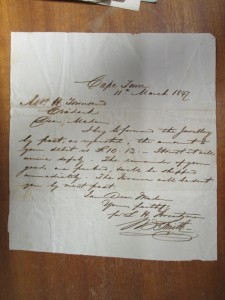The order and the letter
The complications of letterness are there, whichever way one turns in the letter-writing universe, paralleling, mimicking, traversing and displaying its plasticity and flexibility as a form and genre. One such complication can be seen in exchanges of letters between a young widow called Harriet Townsend living on the Eastern Cape frontier during the Seventh and Eighth Frontier Wars (1846-7 and 1851-3) and a merchant, importer and general man of business, WJ Smith, in Cape Town.
Some family connections existed between them, including that Harriet’s mother had used Smith as one of her agents in obtaining goods and raising funds against her family annuity and the two or three small properties she rented. However, the main factor was that Smith was linked by marriage and by business matters – the import and sale of goods and particularly jewellery – to the Townsends, into which family Harriet had married in 1837.
The effects of the Frontier Wars on the economies of the small but bustling and growing white towns in the areas concerned – Grahamstown, Cradock, Seymour and Bedford – were mixed. Some fortunes rose, through profiteering or more legitimate financial opportunities linked to the rumbling conflicts. Others fell, because money was scarce, local farming was severely affected, people’s spending was reined in, Promissory Notes and Bills of Exchange were defaulted on. The fortunes of Edward Townsend, Harriet’s husband, were among those that fell. The effects of the prevailing adverse economic circumstances were exacerbated by his disorganised business practices and also his lack of judgement in taking on Promissory Notes and Bills of Exchange (forms of credit) that no other trader in Grahamstown – where the Townsends had a shop selling jewellery and other high end goods – would touch.
Suddenly, in his late 20s, Edward Townsend died in August 1840, leaving Harriet at 23 with two young children and pregnant with a third. There were also debts due to defaulted payments and no source of income bar the shop and the trading of goods. Step forward Mr Smith among other family connections helping Harriet Townsend to pick up the pieces and venture into business in her own name.
In the – well, what is it? – shown here, Mr Smith has written to ‘Dear Mrs Townsend’.
At the top, there is Smith’s place of address and the date; this is followed by the personal appellation, while the structure of the content is that of a letter; and it also has a usual letter kind of sign-off at the end, and note the complication of a ‘for LWH Twentyman’ surmounting Smith’s own name.
What lies between its start and its end, the content, has some resemblance to a list or an inventory, the content is spare although written in sentences and paragraphs. It is entirely about business matters and concerns Mr Smith reporting on fulfilling Mrs Townsend’s ‘favour’, that is, a letter she had send ordering items she wanted to obtain via Smith, who would then send her orders from Cape Town by ship to Port Elizabeth, where a cart took them to her, initially in Grahamstown and later, when she removed, to Cradock. She then sold them on, both from her shop, and to her circle of ‘country friends’ who lived too far away to come into town apart from occasionally and instead ordered things from her by post.
Smith’s missive is a letter – just about. It has a singular purpose and expedites this in a very focused way indeed. It has much of the inventory about it, it is a detailed response to an order – but there is enough of letterness to pass muster.
Last updated: 10 August 2015





